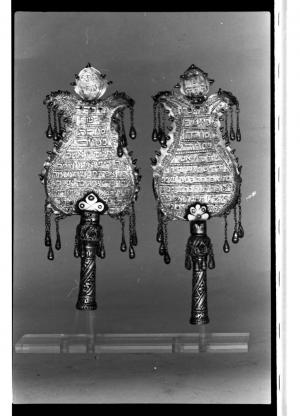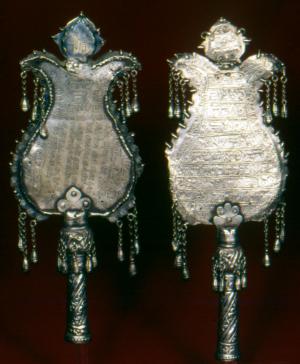Obj. ID: 26220
Sacred and Ritual Objects Torah finials, Afghanistan, circa 1880

The Rimon is made of silver and consists of a shaft and a body.
The shaft is cylindrical and is encircled by a ring of raised points at its bottom. The top of the shaft is surmounted by a globular capital. The shaft and the capital are decorated by winding strips of a floral motif. Eight flattened and slit drop-shaped bells hang from the centre of the capital. The shaft is fastened to the body by a cylindrical element that widens into a floral-shaped clip. The flat body has the shape of a lily. It is made of two parallel engraved plates attached to each other by an indented edge, set with turqouise beads. Along the edges hang chains carrying flattened and slit drop-shaped bells. The body bears engraved inscriptions in square outline letters.
The inscription on the uppermost leaf of the front side reads: יהוה "The Lord", topped by כוזו, a name created by replacing the four letters of God's name by the ones directly succeeding them in the alphabet.
The inscription below reads:
שויתי##ה##לנגדי
"I have set the Lord before me"(Ps. 16:8)
A seven-branched menorah composed of the verses from Ps. 67:1-8 is depicted in the centre, surmounted by the first verse of the Psalm, one word over each branch. The inscription at the top right reads:
בשם צנדלפו "In the name of Zandalphon"
The one at the top left reads:
שדי צבאות "Shaddai~ Zevaot"
The inscription at the bottom left side reads:
בשם נוריאל ## וגבריאל "In the name of Nuriel and Gabriel"
The one at the bottom ride side reads:
בשם רפאל##מיכאל "In the name of Raphae Michael"
The two pairs of angels' names are reversed on Torah finial B.
The inscription on the uppermost leaf on the back of the finials reads:
כתר##תורה "Crown of Torah"
The inscription framing the top part of the back reads:
ברוך שם כבוד מלכותו לעולם [ו]עד
"Blessed be His Glorious Name for ever and ever"
The one at the top right side reads:
אבג יתץ קרע שטן נגד יכש בטר צתג חקב טנע יגל פזק שקו )צית
"42 letter name of God"
The one at the top left side reads:
כל מי שיגנוב אותו או ימכור אותו יהיה בכלל צח קללות תורה
"Who will steal it or sell it will be cursed in 98 curses of the Torah"
The inscription in the centre reads:
יפה ברה "Fair and clean" (based on Cant. 6:10)
כי טוב## סחרה## מסחר## יהלום אשר## הקדיש אותו צרויה## בת אברהם בשם נשמת ## ניסן בר (בן רבי) יחק בר יעקב## גר רית''ע (רוח ה' תניחנו בגן עדן) תנצבה (תהי נשמתו צרורה בצרור החיים) אמן סלה## קדש לית הכנסת מדוד בר יצ''ו (ישמרהו צורו וגואלו
for her merchandise is better than the diamond merchandise (based on Prov. 3:14). Dedicated by Zeruyah, daughter of Abraham in the name of the soul of Nissan son of Rabbi Isaac son of Rabbi Jacob Ger, may the Lord's spirit grant him rest in the Garden of Eden. May his soul be bound up in the bond of life, amen selah. Dedicated to the Synagogue of our teacher David "son of Rabbi. ...may his Rock and Redeemer protect him the righteous, of blessed memory.
On the Torah finial B, the final word יצ''ו is replaced by (זצ''ל (זכר צדיק לברכה "The righteous, ob blessed memory. In addition, a flower appears on Torah finial B instead of the name Nissan, which appears on Torah finial A. זצ''ל is the traditional formula for the commemoration of the deceased. The fact that the name Nissan does not appear on Torah finial B would indicate that the final was made while he was still alive.
The following description was prepared by William Gross:
The finials evolved from knobs at the upper end of the staves (Atzei Chaim) on which the Torah scroll is wound. Since the shape of the spherical finial recalled that of a fruit, it was called a tappu'aḥ, "apple," among the Jews of Spain and in the Sephardi Diaspora, and a rimmon, "pomegranate," in all other communities.
The earliest known reference to Torah finials occurs in a document from 1159, found in the Cairo Genizah, from which we learn that by the 12th century finials were already being made of silver and had bells. Around the same time, Maimonides mentions finials in the Mishneh Torah (Hilkhot Sefer Torah 10:4). Despite the variations on the spherical shape which developed over the centuries and the addition of small bells around the main body of the finial, the spherical, fruit-like form was the basic model for the design of finials in Oriental and European communities.
A most significant variation appeared in 15th-century Spain, Italy, and Germany, where the shape of finials was influenced by that of various objects of church ritual, whose design often incorporated architectural motifs, The resulting tower-like structure, which seems to have appeared around the same time in different parts of Europe, became the main type of finial in 18th-century Germany and Italy, as well as Morocco, brought there by Jews expelled from Spain.
In Afghanistan there existed two types of Torah finials, or "Rimmonim", both globular Rimmonim and flat pairs, such as this, that were called, and often inscribed, "Keter Torah". The Torah case, or "Tik" in Afghanistan had place for three pairs of Rimmonim, with this flat type being in the center. This pair appears to be among the oldest existing examples of the genre. They came with the story that they held a special holy place for the community in which they were used. When someone was ill, a bowl of water was brought to the synagogue into which these Rimmonim were dipped. The sick person then drank the water to which had been transferred the holiness of the Rimmonim. The elaborate inscriptions on this pair contain many amuletic elements, starting from the depiction of a Shiviti with the 67th psalm in the form of a menorah, which in itself was considered to have special power. Additionally there are inscribed the invocation of several angels, by name, as well as the 42 letter name of god and a number of blessings. Added is an inscription which calls biblical curses on anyone who steals or sells these Rimmonim. Donated by Tzarariah bat Avraham In memory of Nissan bar Yitzhak bar Ya'akov.
Inscription:
The front:
Top: Crown of the Torah Superscription: i have set the lord before me (psalms 16:8) Upper right: in the name of sandalphon Upper left: shaddai of the armies.
Lower right: in the name of Raphael, Michael Lower left: in the name of nuriel and Gabriel Center: psalm 67:1-8 in the form of a menorah
The back:
Top: crown of Torah Top frame: blessed be his glorious name for ever ---------------- ever and ever
Right frame: 42 letter name of god (the first letters ---------------- of the 42 words of the hymn "anah ---------------- be'koach"
Left frame: anyone who will steal it or sell it will ---------------- be cursed in 8 curses of the Torah Center: beautiful and clean for the merchandise -- of her is better than the merchandise of -- a diamond (based on song of songs 6:10 -- -- and proverbs 3:14), which was dedicated -- by tzeruyah, daughter of Avraham, in the -- name of the soul of Nissan bar Yitzhak -- -- bar ya'akov ger, god's spirit will lead -- -- him to the garden of Eden, may his soul be -- bound up in the bond of life, amen, Selah. -- dedicated to the synagogue of David -- (missing on one) bar............, of blessed -- memory (on the other: may he be guarded -- by the lord)
sub-set tree:
Fastened by rivets
Set turquoise beads
Engraved
Silver, Turquoise, Chased, Cut, Stamped, Set


















